In October of 2016, we set out to do a camera trapping survey to document leopards within Shimla city, Himachal Pradesh. We did this successfully only because of the help we received from the residents of Shimla, students and forest guards who set up cameras in their respective backyards. This summer retreat hill station has a resident human population density of 4,798 people/sq km. There is also a surprising diversity of wildlife including carnivores (leopards, red fox, jackal) and herbivores (barking deer, goral, langur, rhesus macaque) living alongside people. Although it was satisfying to get photos of leopards after intensive work, it was even more rewarding to see our volunteers take pride in the leopard in their backyard. Through all this, we did encounter a few extraordinary individuals of the human kind.
Our driver, during the initial part of the survey, was a guy who came with great recommendation from one of our team members for being punctual and understanding of ‘our kind’ of work. So, we decided to hire him to take us around the ten camera trap locations spread across Shimla city during the evening and morning hours every day for a month. He complied with the work and even showed enthusiasm in helping us set up cameras for capturing photos of animals in his city. On one such location within the Shimla water catchment sanctuary, he chose to sit in the car when we walked about a kilometer away, set up the camera with the help of the beat guard. Since we were working with the forest department on a wildlife-related survey, the beat guard had made an exception for us to be able to take the car upto the location (7km from the park gate). She was a fiercely independent lady who’s favour we had already won due to our affinity for her favorite species, the leopard. When we walked back to the car, we found it devoid of a driver and car key. Our efforts to contact him were in vain through the half hour that we tried. An hour later, we were able to contact his brother who said that he is coming to pick us up from the park. It was dark by then and the beat guard was furious with the driver. Later we found out that our driver suffered from issues of the mind that no one could explain. He had WALKED seven kms into the forest, where we had evidence of at least two leopards in the area, away from us with the car keys and gone home. To this date, we don’t know why he chose to abandon us and more importantly his car in the middle of a forest at night. But on hindsight, it was a funny story that strengthened our bond with the forest guard who became our close ally during the entire survey period.
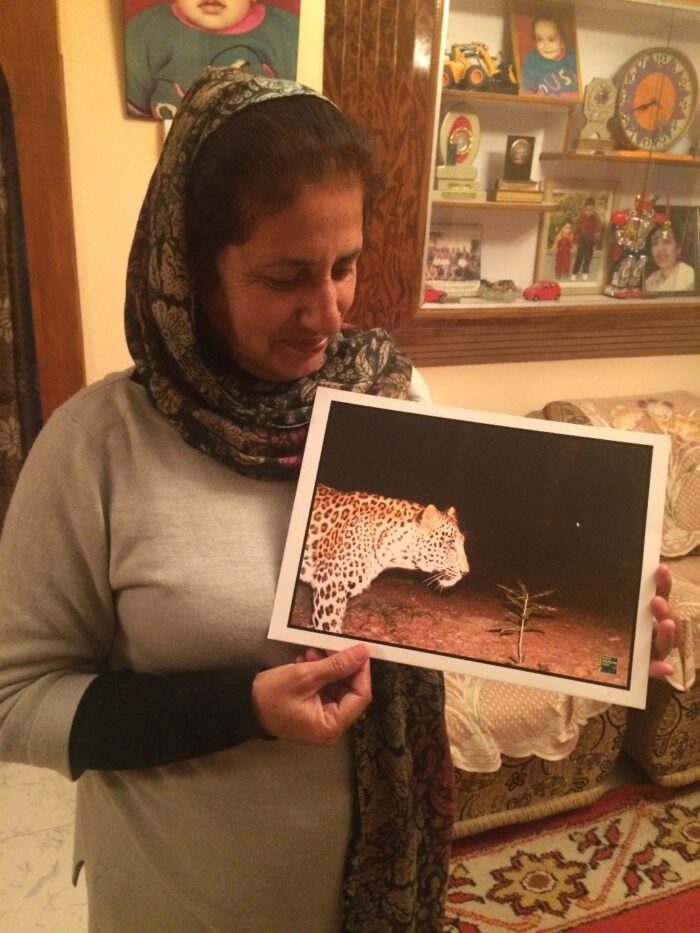
One other location of setting up cameras was a house of two brothers, their six children and a dog. The kids helped us set up camera traps right outside their house every day. The youngest and the only girl was in great excitement to capture a “bau” which was her name for a leopard. Much to the disappointment of the kids, we never managed to capture a leopard at this location, they did however, capture an award-winning image. For a while, their neighborhood was facing problem of power outage much more frequently than other areas and the electricity department couldn’t fathom where the wires they installed were disappearing to. Almost towards the end of our survey period, the kids managed to get a picture of a man carrying what looked like copper-glinting wires past their house. The two brothers instantly made the connection and submitted this photo to the electricity department. The scheming cable ‘chor’ had set up a system where he would cut and strip ground cable by burning them and selling the copper for profit. The electricity department was so grateful that they conferred the brothers with an award for having helped them solve the mystery of the missing wires.
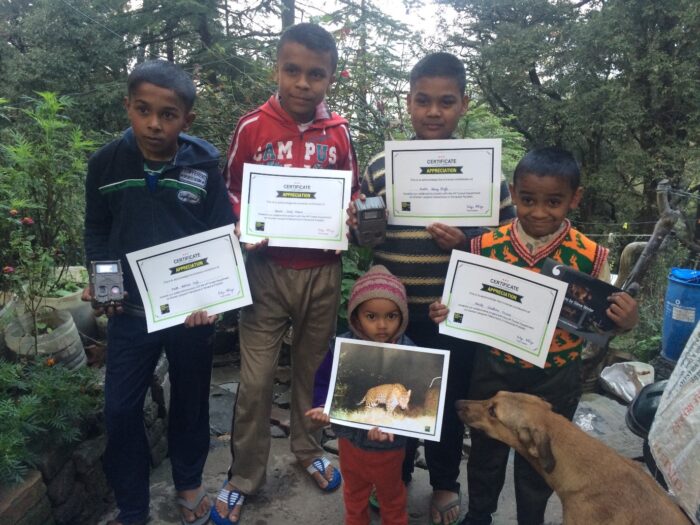
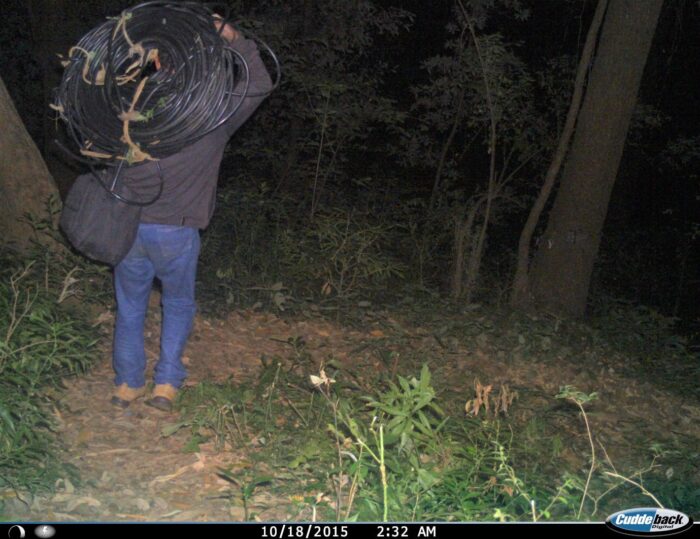
There were other times where the people we interacted with completely baffled us. Like this instance where we had a strange encounter at a remote location at the edge of Shimla city where vehicular traffic was sparse, and trees and forest cover was dense. We parked our car at the bottom of a hill and stepped out to begin our 45-min climb upto the camera trap location. Just as we were packing our bags with the camera equipment, a peculiar man dressed in the drab clothes of a shepherd curiously stepped up to us asking several questions of the purpose of our visit there. We were cautious to give sparse details lest our cameras were stolen by this stranger. He did confirm that he had spotted leopards passing by in the general area we were at. We finally managed to part ways with this man who climbed downhill and four of us started the upward climb to the camera trap location. All through the climb, our driver voiced a lingering feeling that we were being watched. At one such instance, all of us even managed to catch a glimpse of a man in an orange shirt and called out to him to join us for a chat, but he disappeared right the next instant. With the sun rapidly fading, and our sense of fear heightening, we came to the consensus that we will go back up the hill to the camera trap location to retrieve the camera. Our driver Dilip bhaiya had by then even recruited a few local residents who were warning us of “smuggling gangs” that were active in the area. Two of us stayed behind to guard the car. Just as the team trekked out of sight, the peculiar man returned with his cattle herd and enquired if we had finished with our work there. He looked to be on his way home from grazing his cattle. He even enquired why we looked shook up and we mentioned that there was a man following us the whole time. He didn’t stay long to speculate and walked away from us. As he was walking away, he lifted his lathi to his shoulders and there we saw an orange shirt below his shawl! This was the man who had followed us all through our trek through the forest and refused to join us. We were baffled by his behaviour given that we had had a long conversation with him before we began our work. Later, we found out that there were several cases pending against him from the forest department of minor smuggling charges but were not proved due to his mentally imbalanced status. Every time we visited that location we would encounter him at the most unusual times, like when we were answering nature’s calls or right at the moment when we were setting up the camera. He would just appear without a warning and so the location took on a phantasmal feel. Even to this day, when I visit that location, I am on the lookout for the peculiar man with the squint eyes and stalking tendencies. To us and the various residents there, the threat of the strange man didn’t even compare the ‘threat’ of taking photographic evidence of leopards.
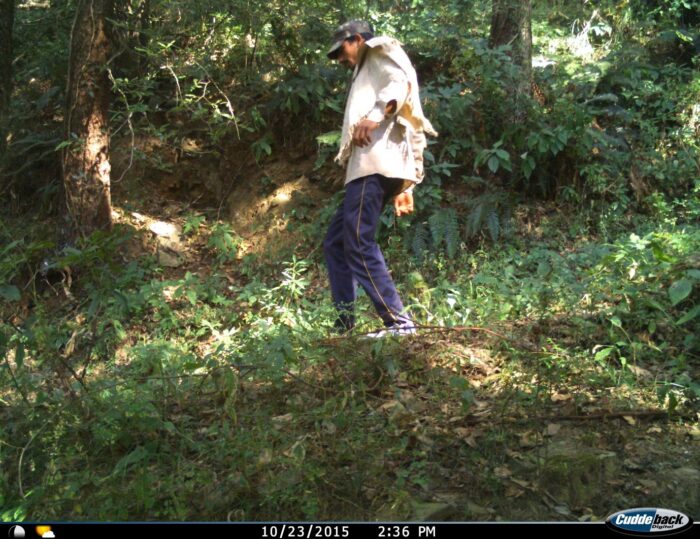
Many of the locations were just outside people’s homes and their nonchalance at a leopard passing by their yards surprised us. What seemed like nonchalance to us, was in fact years of their experience in no negative interactions with this big cat. Like this old gentleman carrying his 5-year-old grandson was telling us “If I make sure to keep my grandson, the dog and livestock inside my house after dusk, the leopard just passes by without bothering us”. Sure enough, we got a leopard on his verandah ten meters from his front door. He wasn’t surprised one bit, in fact he looked rather proud of the photo we gifted him of the leopard we found at his doorstep.
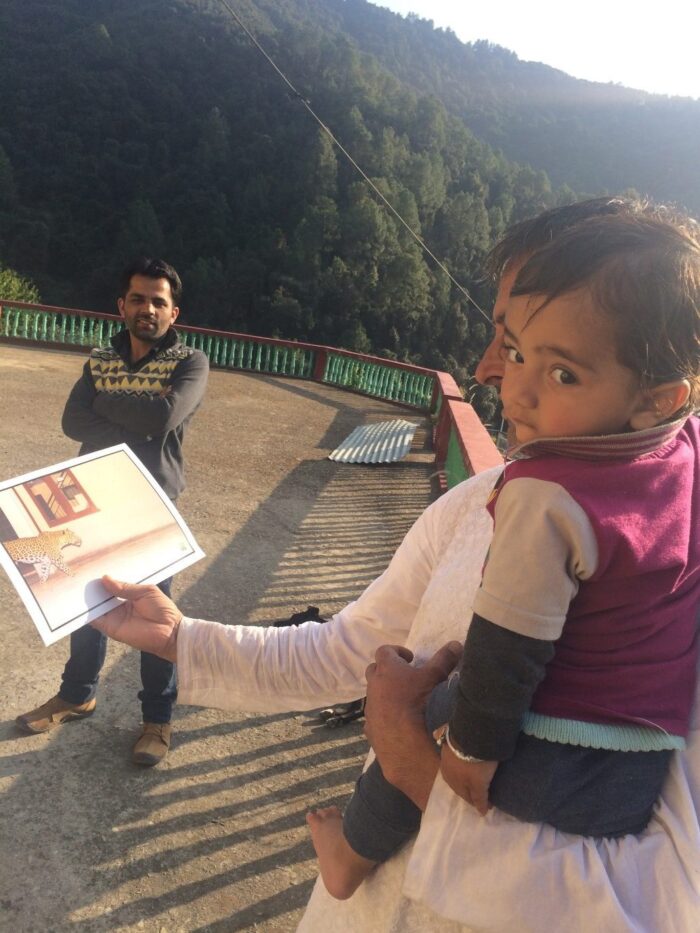
Most of the times, we didn’t have to even check our cameras to know that a leopard had been captured in it, the residents would tell us that it was there. To them, indicators such as the calling of a leopard (the sawing sound leopards make), the dogs barking in a different manner or a power cut already warns them of precautions they must take to live with this animal peacefully. An elderly couple had told us that in all three such instances, they quickly rush down to their dogs’ enclosure (they had two large dogs – one Rottweiler and one Saint Bernard) and make sure they are secure since they didn’t want to lose their two family members to the big cat that comes by to ‘check’ if the owners made a mistake or not today. One mistake by the owner meant a meal for the leopard.
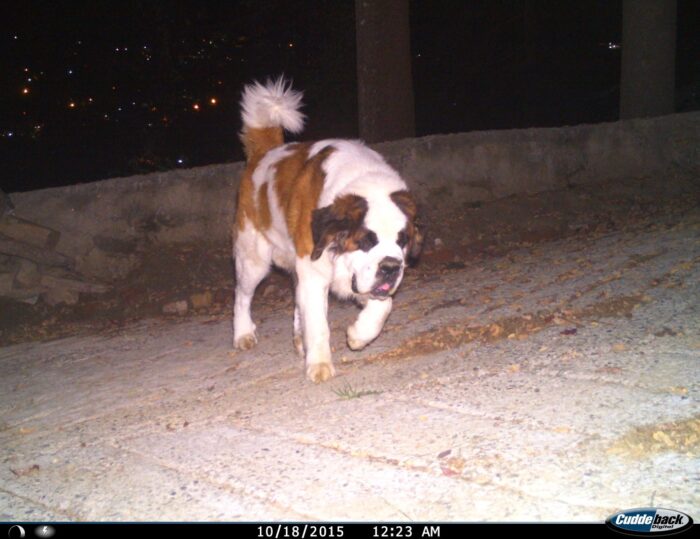
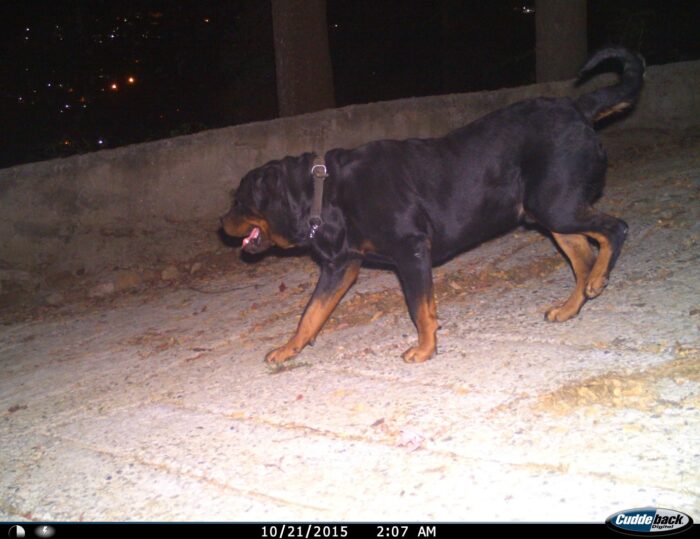
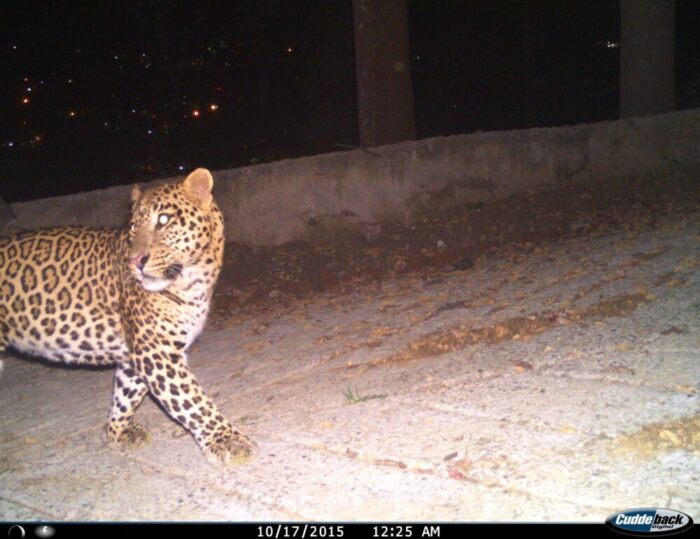
Few other times, we were gratified to see a change in the attitude of our volunteers towards the leopards. There was a youth group which consisted mostly of students not from the local area but very enthusiastic to be doing wildlife work. All of them were diligent but fearful of this big cat that could attack them like how they had read in the papers. The positioning of a camera two girls would set up close to their hostel was such that on their way back, they would trigger the camera and a photo would be taken of them. For almost ten days their camera only gave photos of the girls with the city lights in the background. On the 11th day, they got a female leopard at the exact same spot as where they were being captured by the camera. We thought this would scare them and we would loose two very good volunteers. They were instead overjoyed, and they felt a sense of achievement and continued to visit the location and set up the camera till the end of the survey. They were of course more vary after they saw the leopard photo and not linger at the location just in case they saw the leopard in real time.
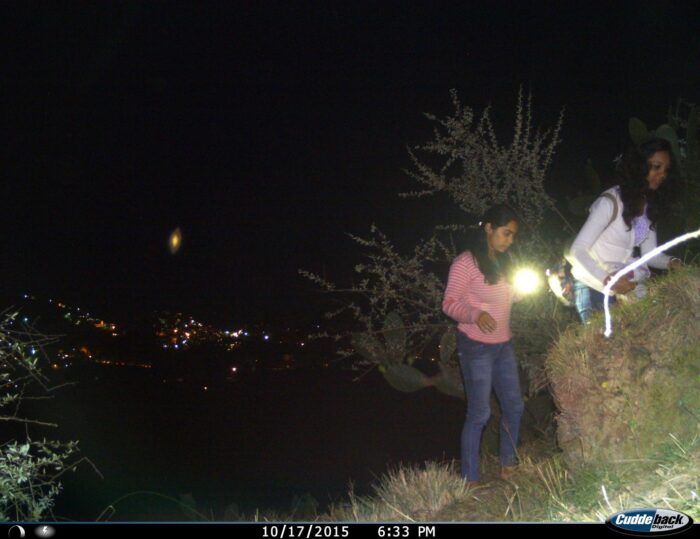
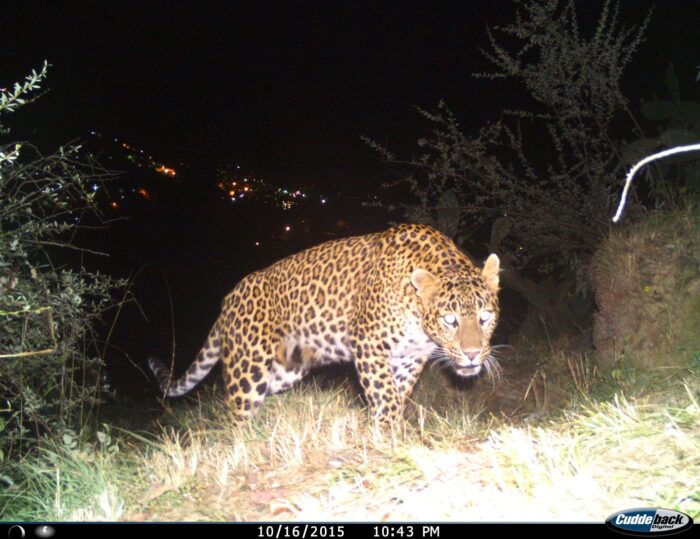
We were also fortunate enough to capture a feline love story in progress during our survey period. The camera location was just outside the cage of a female leopard’s enclosure in a rescue center. The rescue center caretaker and staff had noticed that every night, a leopard would visit her cage and leave by morning. They told us that 100% the male will come the next day since the female leopard is in heat and the male leopard knows it. Their description of the situation made us think of the forbidden love most often shown in Bollywood movies. Sure enough we got a very lovelorn leopard in our camera the very day coming in at 8:00 pm and leaving at 3:00 am the next morning.
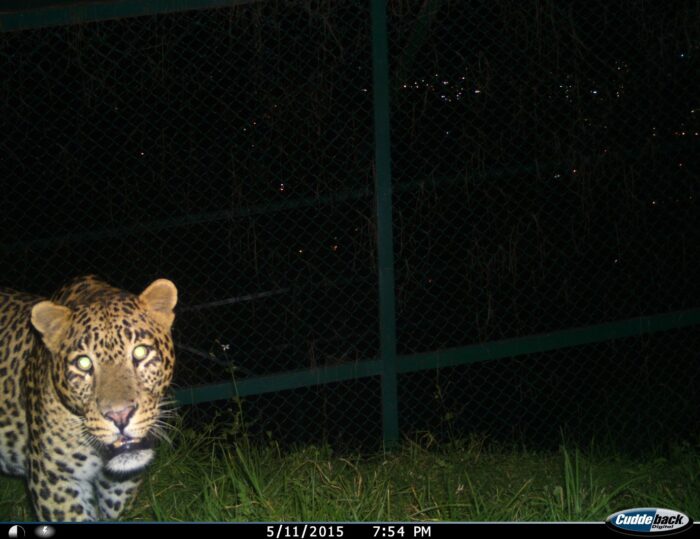
Our survey began with a set agenda and scientific design of wanting to estimate leopards in the municipal limits of Shimla city. Instead, we got to understand the small stories of people who live with these animals daily. The people in the region drew comfort from various stories they had heard from their parents and relatives and although they feared the animal, they never wanted to harm it. Like most people would say that the leopard was the guardian who would make sure to follow you at a distance and drop you off home if you were homeward bound late in the night. For them, the various ‘leopards’ in the region included the spotted leopard that in a resident (mirg), the spotted leopard that was introduced and causes harm to people (tendua), the striped leopard that is too big (bagh), the big cat that has no spots whatsoever, the small leopard that reached upto their knee, the leopard that is bigger than their shoulders. Each of these leopards had certain characteristics and personalities that the people were familiar with; like members of a family with the propensity to be naughty, a wanderer, a tree climber or just sneaky.
According to them, in case the leopard was about to harm you, there were several cautionary tactics you could employ to deter this cat out on his Shikhar. If you were a lady, you could simply let down your hair in front of your face and confuse the leopard as to which is your front, and which is your back and he will no longer bite your throat. If you were to come face to face with a leopard, you must pretend to be dead, and then the leopard will leave you alone. This is because the leopard does not want to eat things that are already dead. If you spot a leopard walking in the same path as you, you must simply walk into another path and not let him know you have spotted him, all the while making sure never to show your back to him. These are cautions that keep the courage up of the people in this region to live with a cat which most often does not follow human-made boundaries. Each of the locations we sampled had their own unique story that showed us the various fears, myths and avatars of this spotted big cats in Shimla residents’ backyards and minds.
Interesting narration and understanding of animal – human relationship.
Keep up the good work